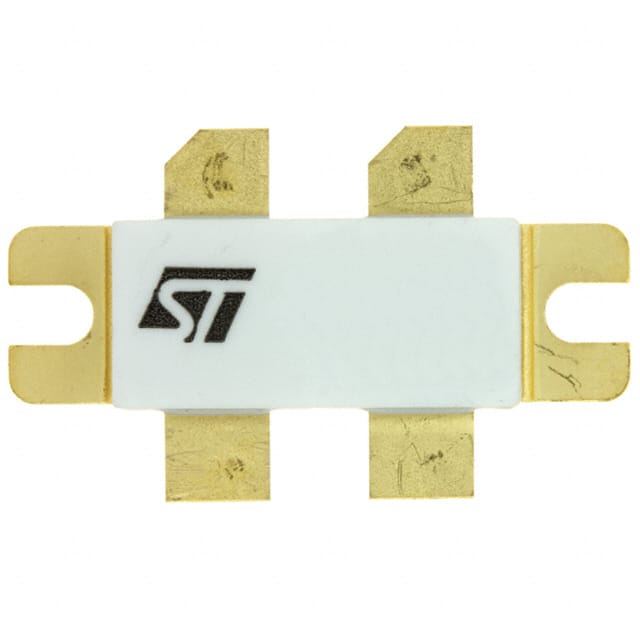SD2932: Product Overview and Detailed Information
Introduction
SD2932 is a high-power RF transistor that belongs to the category of electronic components used in radio frequency (RF) amplification circuits. This product is widely utilized in various applications due to its unique characteristics, packaging, and performance.
Basic Information Overview
- Category: Electronic Components
- Use: RF Amplification Circuits
- Characteristics: High Power, Low Noise, High Gain
- Package: TO-270
- Essence: High-Frequency Transistor
- Packaging/Quantity: Individual or Reel Packaging Options Available
Specifications
- Frequency Range: 500 MHz - 2500 MHz
- Power Output: 150 Watts
- Voltage: 28 Volts
- Current: 15 Amps
- Gain: 13 dB
- Noise Figure: 0.5 dB
Detailed Pin Configuration
The SD2932 transistor has a standard pin configuration with three pins: 1. Pin 1: Source 2. Pin 2: Gate 3. Pin 3: Drain
Functional Features
- High Power Output: Capable of delivering 150 Watts of power.
- Low Noise Figure: Ensures minimal signal degradation during amplification.
- Broad Frequency Range: Suitable for a wide range of RF applications.
- High Gain: Provides significant signal amplification without introducing excessive noise.
Advantages and Disadvantages
Advantages
- High Power Output
- Low Noise Figure
- Wide Frequency Range
- High Gain
Disadvantages
- Higher Cost Compared to Lower Power Transistors
- Requires Adequate Heat Dissipation Measures
Working Principles
The SD2932 operates based on the principles of field-effect transistors (FETs), utilizing its gate-source voltage to control the flow of current between the source and drain terminals. By modulating this voltage, the transistor can amplify RF signals efficiently.
Detailed Application Field Plans
The SD2932 transistor finds extensive use in the following applications: 1. Amateur Radio: Used in high-power RF amplifiers for amateur radio enthusiasts. 2. Telecommunications: Employed in base station amplifiers for cellular networks. 3. Radar Systems: Utilized in radar transmitter modules for high-frequency signal amplification.
Detailed and Complete Alternative Models
For users seeking alternatives to the SD2932, the following models can be considered: 1. SD2933: Similar specifications with higher power output. 2. SD2921: Lower power output with similar characteristics for cost-effective solutions. 3. MRF151G: Comparable performance with different packaging options.
In conclusion, the SD2932 RF transistor offers high power, low noise, and excellent gain characteristics, making it suitable for a wide range of RF amplification applications.
Word Count: 410
قم بإدراج 10 أسئلة وإجابات شائعة تتعلق بتطبيق SD2932 في الحلول التقنية
What is SD2932?
- SD2932 is a high-power RF transistor designed for use in applications such as radio frequency amplifiers and transmitters.
What is the maximum power output of SD2932?
- The maximum power output of SD2932 is typically around 150 watts.
What are the typical operating frequencies for SD2932?
- SD2932 is commonly used in the frequency range of 960-1215 MHz.
What are the key features of SD2932?
- Some key features of SD2932 include high power gain, high efficiency, and excellent thermal stability.
What are the recommended biasing conditions for SD2932?
- The recommended biasing conditions for SD2932 include a collector current of 1.5 A and a base voltage of 6 V.
Can SD2932 be used in Class A amplifier configurations?
- Yes, SD2932 can be used in Class A amplifier configurations, but it is more commonly used in Class AB or Class C configurations due to its high power capabilities.
What are the typical applications of SD2932?
- Typical applications of SD2932 include use in amateur radio amplifiers, broadcast transmitters, and industrial RF systems.
Does SD2932 require any special heat dissipation measures?
- Yes, due to its high power capabilities, SD2932 requires efficient heat dissipation measures such as proper heatsinking and thermal management.
What are the recommended input and output matching networks for SD2932?
- The recommended input and output matching networks for SD2932 depend on the specific application and operating frequency, and should be designed using appropriate RF simulation tools.
Are there any common failure modes associated with SD2932?
- Common failure modes for SD2932 include thermal runaway due to inadequate heat dissipation, overvoltage at the base terminal, and excessive current draw leading to device breakdown. Proper design and operating conditions can mitigate these risks.


